LinuxShell脚本编程实例
- 格式:doc
- 大小:48.00 KB
- 文档页数:8
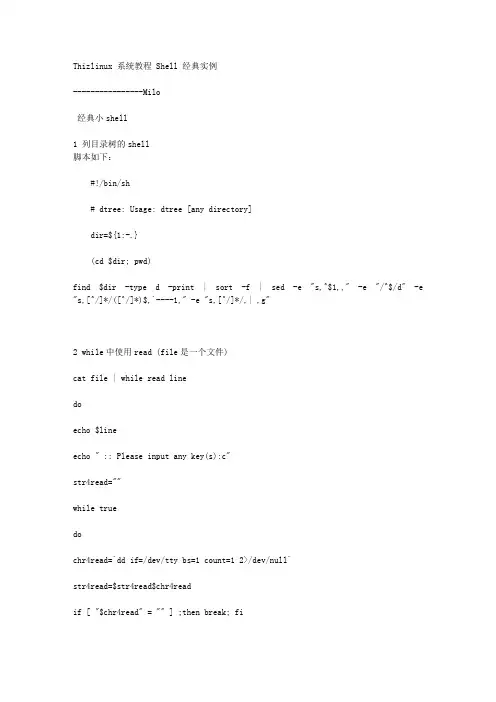
Thizlinux 系统教程 Shell 经典实例----------------Milo经典小shell1 列目录树的shell脚本如下:#!/bin/sh# dtree: Usage: dtree [any directory]dir=${1:-.}(cd $dir; pwd)find $dir -type d -print | sort -f | sed -e "s,^$1,," -e "/^$/d" -e "s,[^/]*/([^/]*)$,`----1," -e "s,[^/]*/,| ,g"2 while中使用read (file是一个文件)cat file | while read linedoecho $lineecho " :: Please input any key(s):c"str4read=""while truedochr4read=`dd if=/dev/tty bs=1 count=1 2>/dev/null`str4read=$str4read$chr4readif [ "$chr4read" = "" ] ;then break; fidoneecho " :: |$str4read|"done3 将多个空格替换为字符sed 's/[ ][ ]*/ /g'如果空格与tab共存时用sed -e 's/[[:space:]][[:space:]]*/ /g' filename4用脚本实现分割文件#!/bin/bashif [ $# -ne 2 ]; thenecho 'Usage: split file size(in bytes)'exitfifile=$1size=$2if [ ! -f $file ]; thenecho "$file doesn't exist"exitfi#TODO: test if $size is a valid integerfilesize=`/bin/ls -l $file | awk '{print $5}'` echo filesize: $filesizelet pieces=$filesize/$sizelet remain=$filesize-$pieces*$sizeif [ $remain -gt 0 ]; thenlet pieces=$pieces+1fiecho pieces: $piecesi=0while [ $i -lt $pieces ];doecho split: $file.$i:dd if=$file of=$file.$i bs=$size count=1 skip=$i let i=$i+1doneecho "#!/bin/bash" > mergeecho "i=0" >> mergeecho "while [ $i -lt $pieces ];" >> mergeecho "do" >> mergeecho " echo merge: $file.$i" >> mergeecho " if [ ! -f $file.$i ]; then" >> mergeecho " echo merge: $file.$i missed" >> mergeecho " rm -f $file.merged" >> mergeecho " exit" >> mergeecho " fi" >> mergeecho " dd if=$file.$i of=$file.merged bs=$size count=1 seek=$i" >> merge echo " let i=$i+1" >> mergeecho "done" >> mergechmod u+x merge'5得到上月未日期,格式为YYYYMMDDget_lastday_of_lastmonth(){yy=`date +%Y`mm=`date +%m-1|bc`[ $mm -lt 1 ] && mm=12;yy=`expr $yy - 1`aaa=`cal $mm $yy`dd=`echo $aaa|awk '{print $NF}'`echo $yy$mm$dd}print $NF的$NF是打印最后一个列。
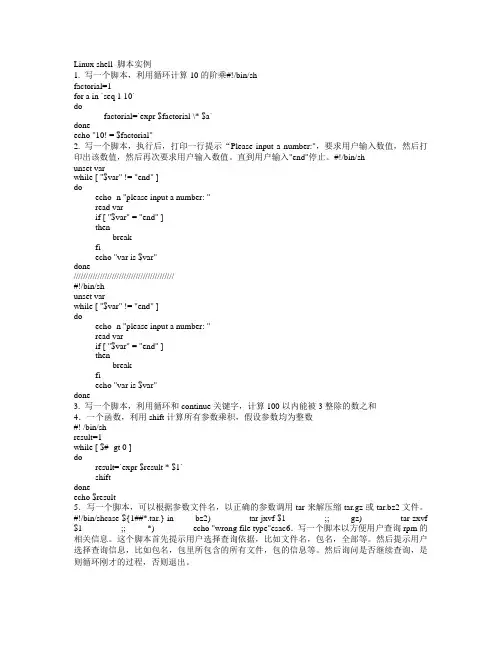
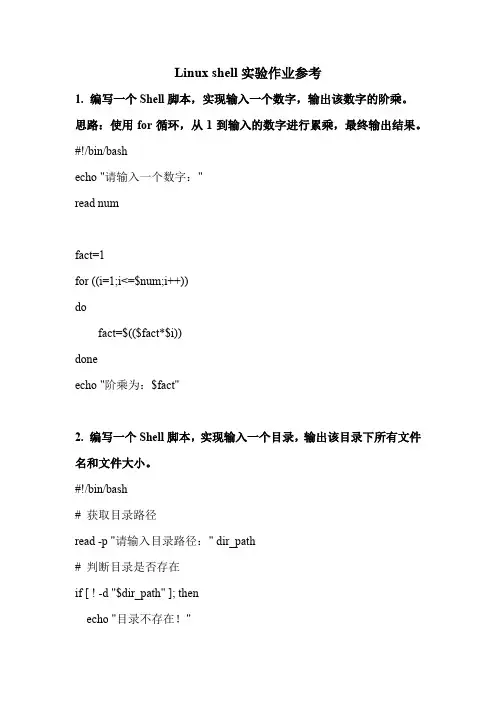
Linux shell实验作业参考1.编写一个Shell脚本,实现输入一个数字,输出该数字的阶乘。
思路:使用for循环,从1到输入的数字进行累乘,最终输出结果。
#!/bin/bashecho "请输入一个数字:"read numfact=1for ((i=1;i<=$num;i++))dofact=$(($fact*$i))doneecho "阶乘为:$fact"2. 编写一个Shell脚本,实现输入一个目录,输出该目录下所有文件名和文件大小。
#!/bin/bash# 获取目录路径read -p "请输入目录路径:" dir_path# 判断目录是否存在if [ ! -d "$dir_path" ]; thenecho "目录不存在!"exit 1fi# 遍历目录下所有文件for file in "$dir_path"/*do# 判断是否是文件if [ -f "$file" ]; then# 获取文件名和大小file_name=$(basename "$file")file_size=$(du -h "$file" | awk '{print $1}')echo "$file_name : $file_size"fidone使用方法:➢将以上代码保存为一个.sh文件,例如:`list_files.sh`➢给该文件添加执行权限:`chmod +x list_files.sh`➢在终端中运行该脚本:`./list_files.sh`,然后输入目录路径即可。
3. 编写一个Shell脚本,实现输入一个字符串,输出该字符串中所有大写字母的个数。
脚本的基本思路是遍历输入的字符串,对于每个字符,判断是否为大写字母,如果是则计数器加一。

shell脚本100例、练习使⽤1、编写hello world脚本#!/bin/bashecho"hello world"2、通过位置变量创建linux系统账户和密码#!/bin/bash#$1是执⾏脚本第⼀个参数 $2是执⾏脚本第⼆个参数useradd "$1"echo"$2" | passwd --stdin "$1"#测试脚本[root@template-host sh1]# sh2.sh aaa 123Changing password for user aaa.passwd: all authentication tokens updated successfully.#测试登录[root@template-host sh1]# su - aaa[aaa@template-host ~]$3、每周五使⽤tar命令备份 /var/log下的所有⽇志⽂件#!/bin/bashtar -czPf log-`date +%y%m%d`.tar.gz /var/log #加P是因为如果不加会出现错误:tar: Removing leading `/' from member names date和+之间注意有空格。
修改系统参数[root@template-host sh1]# crontab -e00 03 * * 5 /data/sh1/3.sh4、⼀键部署LNMP(RPM包版本)#!/bin/bash#此脚本需要提前配置yum源,否则⽆法配置成功。
本脚本使⽤于7.4yum -y install httpdyum -y install mariadb mariadb-devel mariadb-serveryum -y install php php-mysqlsystemctl start httpd mariadb #启动httpd、mariadbsystemctl enable httpd mariadb #加⼊开机⾃启动systemctl status httpd mariadb #查看是否成功5、实时监控本机硬盘内存剩余空间,剩余内存空间⼩于500M,根分区剩余空间⼩于1000M时,发送警报信息到命令⾏#!bin/bash#提取分区剩余空间单位:kbdisk_size=$(df / | awk'/\//{print $4}')#提取内存空间单位Mmem_size=$(free -m | awk'/Mem/{print $4}')while :doif [ $disk_size -le 512000 -o $mem_size -le 1024 ];thenecho"警报:资源不⾜"sleep5fidone6、随机⽣成⼀个100以内的随机数,提⽰⽤户猜数字,提⽰⽤户猜⼤了、猜⼩了、猜对了,直⾄⽤户猜对,脚本结束。
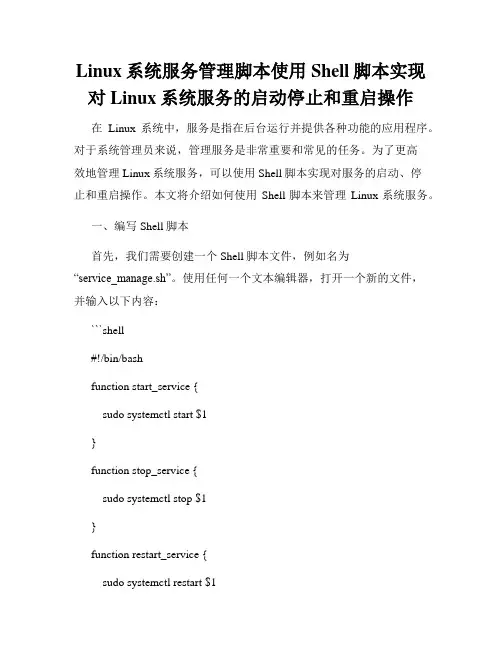
Linux系统服务管理脚本使用Shell脚本实现对Linux系统服务的启动停止和重启操作在Linux系统中,服务是指在后台运行并提供各种功能的应用程序。
对于系统管理员来说,管理服务是非常重要和常见的任务。
为了更高效地管理Linux系统服务,可以使用Shell脚本实现对服务的启动、停止和重启操作。
本文将介绍如何使用Shell脚本来管理Linux系统服务。
一、编写Shell脚本首先,我们需要创建一个Shell脚本文件,例如名为“service_manage.sh”。
使用任何一个文本编辑器,打开一个新的文件,并输入以下内容:```shell#!/bin/bashfunction start_service {sudo systemctl start $1}function stop_service {sudo systemctl stop $1}function restart_service {sudo systemctl restart $1}echo "欢迎使用Linux系统服务管理脚本" echo "请输入您想要执行的操作:"echo "1. 启动服务"echo "2. 停止服务"echo "3. 重启服务"read choicecase $choice in1)echo "请输入要启动的服务名:"read service_namestart_service $service_name;;2)echo "请输入要停止的服务名:"read service_namestop_service $service_name;;echo "请输入要重启的服务名:"read service_namerestart_service $service_name;;*)echo "无效的选择";;esac```上述脚本定义了三个函数:`start_service`、`stop_service`和`restart_service`,分别用于启动、停止和重启服务。

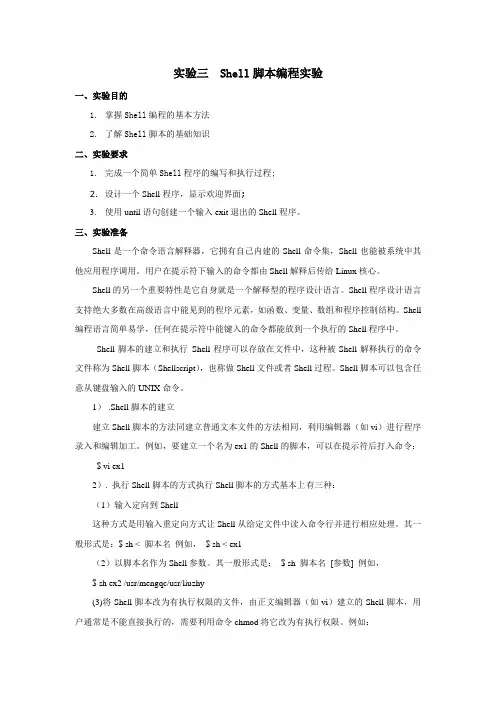
实验三 Shell脚本编程实验一、实验目的1.掌握Shell编程的基本方法2.了解Shell脚本的基础知识二、实验要求1.完成一个简单Shell程序的编写和执行过程;2.设计一个Shell程序,显示欢迎界面;3.使用until语句创建一个输入exit退出的Shell程序。
三、实验准备Shell是一个命令语言解释器,它拥有自己内建的Shell命令集,Shell也能被系统中其他应用程序调用。
用户在提示符下输入的命令都由Shell解释后传给Linux核心。
Shell的另一个重要特性是它自身就是一个解释型的程序设计语言。
Shell程序设计语言支持绝大多数在高级语言中能见到的程序元素,如函数、变量、数组和程序控制结构。
Shell 编程语言简单易学,任何在提示符中能键入的命令都能放到一个执行的Shell程序中。
Shell脚本的建立和执行Shell程序可以存放在文件中,这种被Shell解释执行的命令文件称为Shell脚本(Shellscript),也称做Shell文件或者Shell过程。
Shell脚本可以包含任意从键盘输入的UNIX命令。
1)·.Shell脚本的建立建立Shell脚本的方法同建立普通文本文件的方法相同,利用编辑器(如vi)进行程序录入和编辑加工。
例如,要建立一个名为ex1的Shell的脚本,可以在提示符后打入命令:$ vi ex12). 执行Shell脚本的方式执行Shell脚本的方式基本上有三种:(1)输入定向到Shell这种方式是用输入重定向方式让Shell从给定文件中读入命令行并进行相应处理。
其一般形式是:$ sh < 脚本名例如,$ sh < ex1(2)以脚本名作为Shell参数。
其一般形式是:$ sh 脚本名[参数] 例如,$ sh ex2 /usr/mengqc/usr/liuzhy(3)将Shell脚本改为有执行权限的文件,由正文编辑器(如vi)建立的Shell脚本,用户通常是不能直接执行的,需要利用命令chmod将它改为有执行权限。
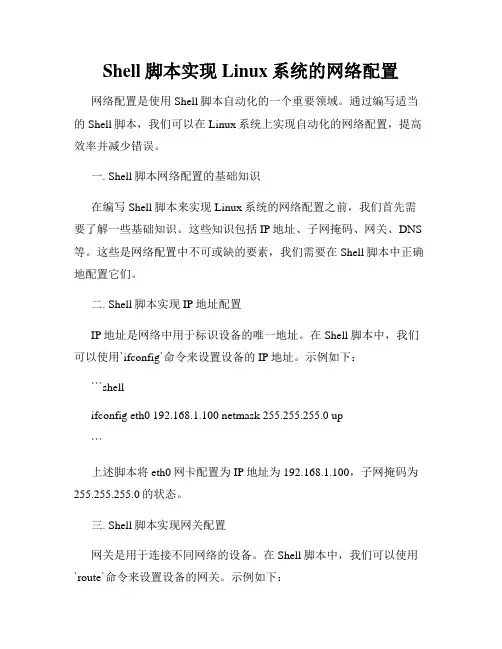
Shell脚本实现Linux系统的网络配置网络配置是使用Shell脚本自动化的一个重要领域。
通过编写适当的Shell脚本,我们可以在Linux系统上实现自动化的网络配置,提高效率并减少错误。
一. Shell脚本网络配置的基础知识在编写Shell脚本来实现Linux系统的网络配置之前,我们首先需要了解一些基础知识。
这些知识包括IP地址、子网掩码、网关、DNS 等。
这些是网络配置中不可或缺的要素,我们需要在Shell脚本中正确地配置它们。
二. Shell脚本实现IP地址配置IP地址是网络中用于标识设备的唯一地址。
在Shell脚本中,我们可以使用`ifconfig`命令来设置设备的IP地址。
示例如下:```shellifconfig eth0 192.168.1.100 netmask 255.255.255.0 up```上述脚本将eth0网卡配置为IP地址为192.168.1.100,子网掩码为255.255.255.0的状态。
三. Shell脚本实现网关配置网关是用于连接不同网络的设备。
在Shell脚本中,我们可以使用`route`命令来设置设备的网关。
示例如下:```shellroute add default gw 192.168.1.1```上述脚本将默认网关设置为192.168.1.1。
四. Shell脚本实现DNS配置DNS(Domain Name System)是用于将域名转换为IP地址的系统。
在Shell脚本中,我们可以使用`/etc/resolv.conf`文件来配置DNS服务器。
示例如下:```shellecho "nameserver 8.8.8.8" > /etc/resolv.conf```上述脚本将DNS服务器设置为8.8.8.8。
五. Shell脚本实现网络配置的自动化为了进一步简化网络配置的过程,我们可以编写一个Shell脚本来实现自动化配置。

linux实验三Shell编程实验三:Shell编程一.实验目的巩固所学的Linux下shell编程语言,熟悉Shell脚本。
二.实验内容1.建立一个test目录2.进入此test目录3.新建文件test1,运行下面shell脚本#!/bin/sha = "hello world"echo $a回答此脚本运行结果4.下面两种脚本,哪一个能够输出语句this is the 2nd①num=2echo "this is the $numnd"②num=2echo "this is the ${num}nd"5.若有如下shell脚本注意:空格很重要。
要确保方括号里的空格#!/bin/shif [ "$SHELL" = "/bin/bash" ]; thenecho "your login shell is the bash (bourne again shell)" else echo "your login shell is not bash but $SHELL"fi①请回答此脚本中提到的环境变量②请回答此脚本的功能6.若有如下shell脚本#!/bin/shn=0while read line;dolet "a+=$line"let "n+=1"done < filetest.txtecho $necho $a①请回答此脚本中是否包含循环,若有实现什么操作?②请回答此脚本的功能7.①新建文件test2,运行下面shell脚本#!/bin/bashecho "Your choice?"select var in "a" "b" "c"; dobreakdoneecho $var请回答此脚本运行结果②给出你对下面脚本的理解#!/bin/shecho "What is your favourite OS?"select var in "Linux" "Gnu Hurd" "Free BSD" "Other"; do breakdoneecho "You have selected $var"8.阅读下面脚本#!/bin/shhelp(){cat <This is a generic command line parser demo.USAGE EXAMPLE: cmdparser -l hello -f -- -somefile1somefile2HELPexit 0}while [ -n "$1" ]; docase $1 in-h) help;shift 1;; # function help is called-f) opt_f=1;shift 1;; # variable opt_f is set-l) opt_l=$2;shift 2;; # -l takes an argument -> shift by 2--) shift;break;; # end of options-*) echo "error: no such option $1. -h for help";exit 1;;*) break;;esacdoneecho "opt_f is $opt_f"echo "opt_l is $opt_l"echo "first arg is $1"echo "2nd arg is $2"注意:shift作用是移除当前参数,若shift 2则移除当前和下一个参数①此shell中case语句试图实现什么功能?②若将shell保存为cmdparser,则执行cmdparser -l hello -f -- -somefile1 somefile2会有什么结果?9.阅读下面shell脚本#!/bin/bashif [ $# -lt 3 ]; thencat<<help< p="">ren -- renames a number of files using sed regular expressionsUSAGE: ren 'regexp' 'replacement' filesEXAMPLE: rename all *.HTM files in *.html:ren 'HTM$' 'html' *.HTMHELPexit 0fiOLD="$1"NEW="$2"# The shift command removes one argument from the list of # command line arguments.shiftshift# $* contains now all the files:for file in $*; doif [ -f "$file" ]; thennewfile=`echo "$file" | sed "s/${OLD}/${NEW}/g"`if [ -f "$newfile" ]; thenecho "ERROR: $newfile exists already"elseecho "renaming $file to $newfile "mv "$file" "$newfile"fifidone注意:sed基本上可以看成一个查找替换程序,从标准输入读入文本,并将结果输出到标准输出,sed使用正则表达式进行搜索。
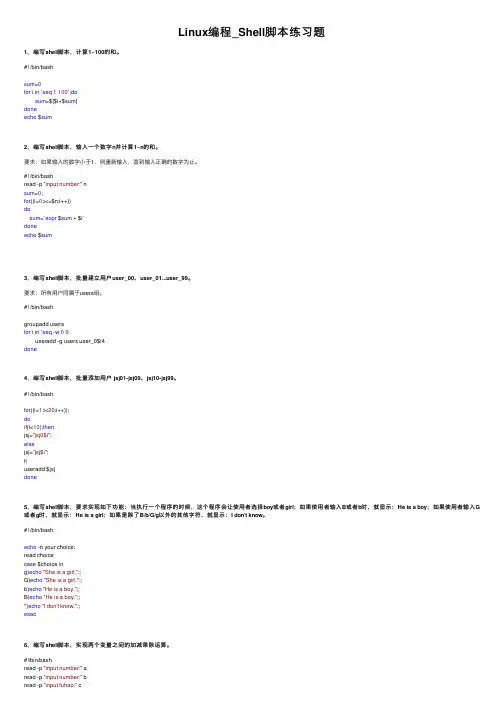
Linux编程_Shell脚本练习题1,编写shell脚本,计算1~100的和。
#! /bin/bashsum=0for i in `seq1100`;dosum=$[$i+$sum]doneecho $sum2,编写shell脚本,输⼊⼀个数字n并计算1~n的和。
要求:如果输⼊的数字⼩于1,则重新输⼊,直到输⼊正确的数字为⽌。
#! /bin/bashread -p "input number:" nsum=0;for((i=0;i<=$n;i++))dosum=`expr $sum + $i`doneecho $sum3,编写shell脚本,批量建⽴⽤户user_00、user_er_99。
要求:所有⽤户同属于users组。
#! /bin/bashgroupadd usersfor i in `seq -w09uesradd -g users user_0$i4done4,编写shell脚本,批量添加⽤户 jsj01-jsj09、jsj10-jsj99。
#! /bin/bashfor((i=1;i<20;i++));doif(i<10);thenjsj="jsj0$i";elsejsj="jsj$i";fiuseradd $jsjdone5,编写shell脚本,要求实现如下功能:当执⾏⼀个程序的时候,这个程序会让使⽤者选择boy或者girl;如果使⽤者输⼊B或者b时,就显⽰:He is a boy;如果使⽤者输⼊G 或者g时,就显⽰:He is a girl;如果是除了B/b/G/g以外的其他字符,就显⽰:I don’t know。
#! /bin/bashecho -n your choice:read choicecase $choice ing)echo"She is a girl.";;G)echo"She is a girl.";;b)echo"He is a boy.";;B)echo"He is a boy.";;*)echo"I don't know.";;esac6,编写shell脚本,实现两个变量之间的加减乘除运算。
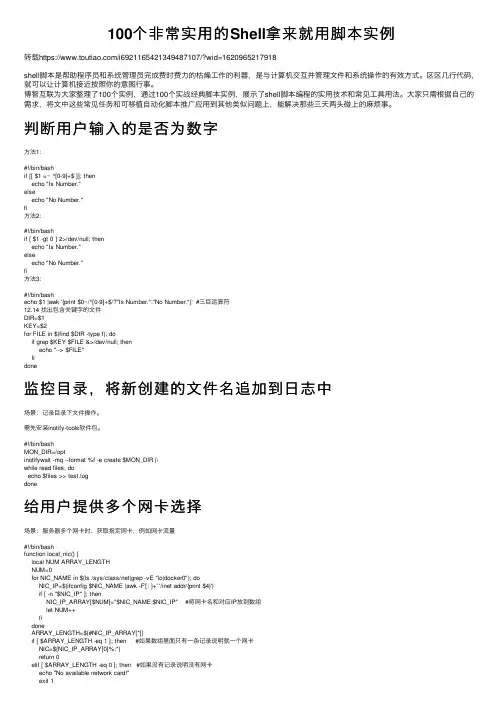
100个⾮常实⽤的Shell拿来就⽤脚本实例转载https:///i6921165421349487107/?wid=1620965217918shell脚本是帮助程序员和系统管理员完成费时费⼒的枯燥⼯作的利器,是与计算机交互并管理⽂件和系统操作的有效⽅式。
区区⼏⾏代码,就可以让计算机接近按照你的意图⾏事。
博智互联为⼤家整理了100个实例,通过100个实战经典脚本实例,展⽰了shell脚本编程的实⽤技术和常见⼯具⽤法。
⼤家只需根据⾃⼰的需求,将⽂中这些常见任务和可移植⾃动化脚本推⼴应⽤到其他类似问题上,能解决那些三天两头碰上的⿇烦事。
判断⽤户输⼊的是否为数字⽅法1:#!/bin/bashif [[ $1 =~ ^[0-9]+$ ]]; thenecho "Is Number."elseecho "No Number."fi⽅法2:#!/bin/bashif [ $1 -gt 0 ] 2>/dev/null; thenecho "Is Number."elseecho "No Number."fi⽅法3:#!/bin/bashecho $1 |awk '{print $0~/^[0-9]+$/?"Is Number.":"No Number."}' #三⽬运算符12.14 找出包含关键字的⽂件DIR=$1KEY=$2for FILE in $(find $DIR -type f); doif grep $KEY $FILE &>/dev/null; thenecho "--> $FILE"fidone监控⽬录,将新创建的⽂件名追加到⽇志中场景:记录⽬录下⽂件操作。
需先安装inotify-tools软件包。
#!/bin/bashMON_DIR=/optinotifywait -mq --format %f -e create $MON_DIR |\while read files; doecho $files >> test.logdone给⽤户提供多个⽹卡选择场景:服务器多个⽹卡时,获取指定⽹卡,例如⽹卡流量#!/bin/bashfunction local_nic() {local NUM ARRAY_LENGTHNUM=0for NIC_NAME in $(ls /sys/class/net|grep -vE "lo|docker0"); doNIC_IP=$(ifconfig $NIC_NAME |awk -F'[: ]+' '/inet addr/{print $4}')if [ -n "$NIC_IP" ]; thenNIC_IP_ARRAY[$NUM]="$NIC_NAME:$NIC_IP" #将⽹卡名和对应IP放到数组let NUM++fidoneARRAY_LENGTH=${#NIC_IP_ARRAY[*]}if [ $ARRAY_LENGTH -eq 1 ]; then #如果数组⾥⾯只有⼀条记录说明就⼀个⽹卡NIC=${NIC_IP_ARRAY[0]%:*}return 0elif [ $ARRAY_LENGTH -eq 0 ]; then #如果没有记录说明没有⽹卡echo "No available network card!"exit 1else#如果有多条记录则提醒输⼊选择for NIC in ${NIC_IP_ARRAY[*]}; doecho $NICdonewhile true; doread -p "Please enter local use to network card name: " INPUT_NIC_NAMECOUNT=0for NIC in ${NIC_IP_ARRAY[*]}; doNIC_NAME=${NIC%:*}if [ $NIC_NAME == "$INPUT_NIC_NAME" ]; thenNIC=${NIC_IP_ARRAY[$COUNT]%:*}return 0elseCOUNT+=1fidoneecho "Not match! Please input again."donefi}local_nicMySQL数据库备份#!/bin/bashDATE=$(date +%F_%H-%M-%S)HOST=192.168.1.120DB=testUSER=bakPASS=123456MAIL="zhangsan@ lisi@"BACKUP_DIR=/data/db_backupSQL_FILE=${DB}_full_$DATE.sqlBAK_FILE=${DB}_full_$DATE.zipcd $BACKUP_DIRif mysqldump -h$HOST -u$USER -p$PASS --single-transaction --routines --triggers -B $DB > $SQL_FILE; thenzip $BAK_FILE $SQL_FILE && rm -f $SQL_FILEif [ ! -s $BAK_FILE ]; thenecho "$DATE 内容" | mail -s "主题" $MAILfielseecho "$DATE 内容" | mail -s "主题" $MAILfifind $BACKUP_DIR -name '*.zip' -ctime +14 -exec rm {} \;Nginx服务管理脚本场景:使⽤源码包安装Nginx不含带服务管理脚本,也就是不能使⽤"service nginx start"或"/etc/init.d/nginx start",所以写了以下的服务管理脚本。
Linux系统定时任务脚本使用Shell脚本实现对Linux系统的定时任务调度和执行在Linux系统中,我们经常需要执行定时任务来完成一些自动化的工作,例如定期备份数据、定时清理临时文件等。
而在Linux系统中,我们可以使用Shell脚本来实现对定时任务的灵活控制和调度。
本文将介绍如何使用Shell脚本在Linux系统中实现定时任务的调度和执行。
一、Shell脚本基础在开始介绍定时任务的使用之前,我们首先需要了解一些Shell脚本的基础知识。
Shell脚本是一种以Shell(命令行解释器)为解释器的脚本语言,用于批处理任务和自动化操作。
在Linux系统中,我们可以使用各种Shell脚本编写工具,例如Bash、Sh、Csh等。
Shell脚本主要由命令、变量、条件判断、循环等组成。
我们可以使用Shell脚本来执行各种操作,例如创建文件、修改文件权限、运行程序等。
而对于定时任务,我们可以使用Shell脚本来编写一段特定的代码,然后在指定的时间点进行执行。
二、定时任务的调度在Linux系统中,我们可以通过使用crontab命令来实现定时任务的调度。
crontab是一个用于设置定时任务的命令,它可以让我们方便地进行任务的调度和执行。
1. 编写定时任务脚本首先,我们需要编写一个定时任务脚本。
这个脚本可以包含我们想要执行的一系列任务,例如备份数据、清理临时文件等。
下面是一个简单的定时任务脚本示例:```shell#!/bin/bash# 备份数据cp /data/*.txt /backup# 清理临时文件rm -rf /tmp/*```在这个脚本中,我们使用cp命令来将`/data`目录下的所有txt文件复制到`/backup`目录中,然后使用rm命令来清空`/tmp`目录下的所有文件。
2. 编辑crontab任务表接下来,我们需要编辑crontab任务表,将我们编写的定时任务脚本添加到任务列表中。
我们可以使用以下命令来编辑crontab任务表:```shellcrontab -e```编辑任务表时,我们可以按照一定的格式来设置定时任务的执行时间和任务命令。
Linux编程执行shell程序编辑完greeting文件后,还不能立即执行,要执行该文件中的shell脚本,首先应当使用chmod命令打开该文件的可执行权限,然后,就可以像运行其他Linux命令那样执行它了。
如图16所示。
使用带-l选项的ls命令可以检查该文件的访问权限,如图17所示:图17 查看文件权限图18 执行shell程序(一)下面,可以像在命令行上执行其他shell命令那样执行greeting了,如图18所示。
读者要注意,这里的mydir是当前工作目录root中的子目录,greeting就位于mydir中。
该程序执行后,根据当前登录用户的名字,显示出了相应的问候信息。
可以看出,在执行程序时给出了完整的路径;除此之外,也可以不给出可执行文件的完整路径,而只给出文件名,这需要首先在当前用户(这里为root)的工作目录中建立一个名为bin的子目录(如果已有,就无需再建了),然后,把已被打开可执行权限的文件greeting复制到bin目录中。
如图19所示:图19 执行shell程序(二)这样能使程序运行,是因为Fedora默认设置的用户shell环境中包含可执行路径$HOME/bin。
通过管道将env命令的输出传递给fgrep可以查看该环境变量PATH,如图20所示:图20 查看环境变量PATH(一)图21 查看环境变量PA TH(二)可以看到,用户(本例中为root)可以使用新的bin目录来包含可执行文件。
查看环境变量的另一种快捷方式是使用带环境变量名(本例中为$PATH)的echo命令。
如图21所示。
也可以在指定的shell(例如tcsh)下执行位于root/bin目录中的greeting,如图22所示:图22 执行shell程序(三)图23 执行shell程序(四)该命令行调用了一个新的tcsh shell,并将文件名greeting作为参数传递给该shell以执行此文件。
其实,在执行一个shell程序之前,也可以不使用chmod +x命令打开相应文件的可执行权限,只需告诉Fedora该文件是一个可以执行的脚本文件。
linuxshell编程案例Linux Shell编程案例Shell编程是一种在Linux操作系统中使用Shell脚本语言编写脚本的技术。
通过Shell编程,我们可以自动化执行一系列的命令,提高工作效率。
下面,我将介绍一个实际的Shell编程案例,帮助大家更好地理解和应用Shell编程。
案例背景:假设我们是一家电商公司的运维工程师,每天需要备份公司的数据库,并将备份文件上传到远程服务器上。
为了简化这个繁琐的过程,我们可以使用Shell编程来实现自动备份和上传。
案例步骤:1. 创建Shell脚本文件首先,我们需要创建一个Shell脚本文件,比如命名为backup.sh。
可以使用任何文本编辑器来创建该文件。
2. 编写脚本内容在backup.sh文件中,我们需要编写一系列的命令来实现备份和上传的功能。
下面是一个简单的示例:```shell#!/bin/bash# 定义备份文件名和路径backup_file="db_backup_$(date +%Y%m%d).sql"backup_path="/path/to/backup"# 备份数据库mysqldump -u username -p password database >$backup_path/$backup_file# 上传备份文件到远程服务器scp $backup_path/$backup_file user@remote_server:/path/to/backup```在这个示例中,我们首先定义了备份文件的名称和路径。
然后,使用`mysqldump`命令备份数据库,并将备份文件保存到指定的路径中。
最后,使用`scp`命令将备份文件上传到远程服务器上。
3. 添加执行权限在终端中,使用`chmod +x backup.sh`命令为脚本文件添加执行权限。
4. 执行脚本在终端中,使用`./backup.sh`命令执行脚本。
Linux系统用户登录记录Shell脚本Shell脚本是一种编程语言,它可以在Linux系统中自动化执行任务。
在Linux系统中,可以使用Shell脚本来记录用户的登录信息。
本文将介绍如何编写一个用于记录Linux系统用户登录记录的Shell脚本。
## 1. 引言用户登录记录是一项重要的安全措施,它可以帮助系统管理员跟踪和审核用户登录活动。
通过编写一个Shell脚本,我们可以方便地记录用户的登录信息,以加强系统的安全性。
## 2. 获取用户登录信息首先,我们需要获取用户登录信息。
在Linux系统中,用户的登录信息通常存储在`/var/log/secure`文件中。
我们可以使用`grep`命令来筛选出登录相关的日志信息。
```shellgrep "Accepted password" /var/log/secure```上述命令将过滤`/var/log/secure`文件中包含"Accepted password"关键词的行。
这些行包含了用户成功登录的信息。
## 3. 提取用户登录信息从登录日志中提取用户的登录信息是我们下一步的目标。
我们需要解析日志行,获取用户名和登录时间。
```shellawk -F ' ' '{print $1, $2, $3, $10}' /var/log/secure```上述命令使用`awk`指令,使用空格作为分隔符,并打印第1、2、3和10个字段,即用户名、主机名、登录时间和登录状态。
通过这个命令,我们可以从日志中提取出用户的登录信息。
## 4. 记录用户登录信息现在我们已经获取到了用户的登录信息,接下来我们需要将这些信息记录下来。
我们可以使用`echo`命令将信息写入一个日志文件中。
```shellecho "$username logged in at $time from $host" >> /var/log/login.log ```上述命令将用户的登录信息写入`/var/log/login.log`文件中。
1、打印位置变量的个数和位置变量的内容#! /bin/shecho "Current command is $0"echo "The first parameter is $1"echo "The second parameter is $2"echo "The third parameter is $3"echo "Total of parameters if $#"echo "Current PID is $$"2、循环打印“I love linux”3次#!/bin/bashtimes=0until [ "$times" = 3 ];doecho "I love linux."sleep 2times=`expr $times + 1`done3、完成菜单程序的功能:1)列出当前的文件2)更改路径3)编辑文件4)删除文件#!/bin/bash# menu shell script.untilecho "List Directory..........1"echo "Change Directory........2"echo "Edit File...............3"echo "Remove File.............4"echo "Exit Menu...............5"read choicetest $choice = 5docase $choice in1) ls;;2) echo "enter target directory:"read dircd $dir;;3) echo "enter file name:"read filevi $file;;4) echo "enter file name:"read filerm $file;;5) echo "Goodbye";;*) echo "illegal option, please input again." esacdone#! /bin/shvar1="abcd efg"echo $var1var2=1234echo "The value of var2 is $var2"echo $HOMEecho $PATHecho $PWD#! /bin/shnum=0while [ $num -le 10 ]donum=`expr $num + 1`if [ $num -eq 5 ]thencontinuefisquare=`expr $num \* $num`echo $squaredone#!/bin/bash# Gnu bash versions 2.x# The Party Program--Invitations to friends from the# "guest" fileguestfile=./guests # ~/shell/guestsif [[ ! -e "$guestfile" ]]thenprintf "${guestfile##*/} non-existent"exit 1fiexport PLACE="Sarotini's"(( Time=$(date +%H) + 1 ))set cheese crackers shrimp drinks "hot dogs" sandwichesfor person in $(cat $guestfile)doif [[ $person = root ]]thencontinueelse# Start of here documentmail -v -s "Party" $personHi ${person}! Please join me at $PLACE for a party!Meet me at $Time o'clock.I'll bring the ice cream. Would you please bring $1and anything else you would like to eat? Let me knowif you can't make it.Hope to see you soon.Your pal,ellie@$(hostname)FINISshiftif (( $# == 0 ))thenset cheese crackers shrimp drinks "hot dogs" sandwiches fifidoneprintf "Bye..."#!/bin/sh# Standard AT&T Bourne Shell# The Party Program--Invitations to friends from the# "guest" fileguestfile=./guests # /home/ellie/shell/guestsif [ ! -f "$guestfile" ]thenecho "慴asename $guestfile?non-existent"exit 1fiPLACE="Sarotini's"export PLACETime=`date +%H`Time=`expr $Time + 1`set cheese crackers shrimp drinks "hot dogs" sandwichesfor person in $(cat $guestfile)doif [ $person = root ]]thencontinueelse# Start of here documentmail -v -s "Party" $personHi $person! Please join me at $PLACE for a party!Meet me at $Time o'clock.I'll bring the ice cream. Would you please bring $1and anything else you would like to eat? Let me knowif you can't make it.Hope to see you soon.Your pal,ellie@`hostname`FINISshiftif [ $# -eq 0 ]thenset cheese crackers shrimp drinks "hot dogs" sandwiches fifidoneecho "Bye..."#!/bin/sh# Scriptname: args# Script to test command line argumentsecho The name of this script is $0.echo The arguments are $*.echo The first argument is $1.echo The second argument is $2.echo The number of arguments is $#.oldargs=$*set Jake Nicky Scott # reset the positional parameters echo All the positional parameters are $*.echo The number of postional parameters is $#.echo "Good~Vbye for now, $1 "set $(date) # reset the positional parametersecho The date is $2 $3, $6.echo "The value of \$oldargs is $oldargs."set $oldargsecho $1 $2 $3# Name: bigfiles# Purpose: Use the find command to find any files in the root # partition that have not been modified within the past n (any # number within 30 days) days and are larger than 20 blocks# (512 byte blocks)if (( $# != 2 )) # or [ $# -ne 2 ]thenecho "Usage: $0 mdays size " 1>&2exit 1fiif (( $1 0 || $1 > 30 )) # or [ $1 -lt 0 -o $1 -gt 30 ] thenecho "mdays is out of range"exit 2fiif (( $2 # or [ $2 -le 20 ]thenecho "size is out of range"exit 3fifind / -xdev -mtime $1 -size +$2#!/bin/bash# Scriptname: checker# Script to demonstrate the use of special variable# modifiers and argumentsname=${1:?"requires an argument" }echo Hello $name#!/bin/bash# This is the first Bash shell program of the day.# Scriptname: greetings# Written by: Barbara Bashfulecho "Hello $LOGNAME, it's nice talking to you."echo "Your present working directory is `pwd`."echo "You are working on a machine called `uname -n`."echo "Here is a list of your files."ls # list files in the present working directoryecho "Bye for now $LOGNAME. The time is `date +%T`!"#!/bin/bash# Scriptname: greetings2echo "This script is called $0."echo "$0 $1 and $2"echo "The number of positional parameters is $#"#!/bin/bash# Scriptname: idcheck# purpose:check user id to see if user is root.# Only root has a uid of 0.# Format for id output:uid=9496(ellie) gid=40 groups=40# root's uid=0id=`id | gawk -F'[=(]' '{print $2}'` # get user idecho your user id is: $idif (( id == 0 )) # or [ $id -eq 0 ]thenecho "you are superuser."elseecho "you are not superuser."fiShell编程实例一该实例的功能是按照/etc/hosts文件中的条目逐一ping所有的机器。